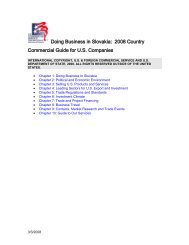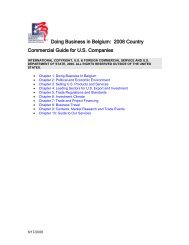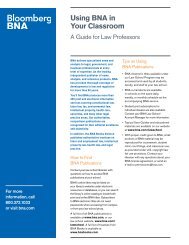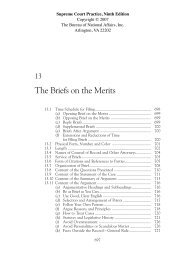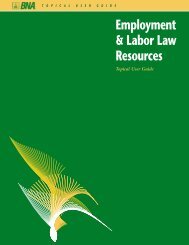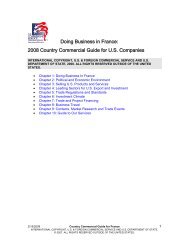Create successful ePaper yourself
Turn your PDF publications into a flip-book with our unique Google optimized e-Paper software.
<strong>In</strong> January 2002, the government ended convertibility and defaulted on roughly $82<br />
billion in privately held debt and over $6 billion in debt to official government creditors<br />
(including approximately $360 million owed to the U.S. government). <strong>In</strong> February 2005,<br />
private investors holding 76 percent of <strong>Argentina</strong>'s defaulted debt accepted an Argentine<br />
government offer of approximately 30 cents on the dollar of old debt. Some remaining<br />
"holdout" private bondholders are still actively seeking redress but, as of this writing, the<br />
GOA has declined to engage with private bondholders who chose not to participate in<br />
the 2005 restructuring. Of the over $6 billion owed to official government creditors, over<br />
$4 billion consists of arrears and past-due interest. The GOA has indicated interest in<br />
normalizing its relationship with official government creditors.<br />
<strong>Argentina</strong> posted real GDP growth of 8.8 percent in 2003, 9.0 percent in 2004, 9.2<br />
percent in 2005, 8.4 percent in 2006, and an estimated 8.5 percent in 2007. This<br />
impressive economic recovery, which has also led to improvements in key socioeconomic<br />
indicators, can be attributed to a number of factors. These include <strong>Argentina</strong>’s<br />
post-crisis move to a flexible exchange rate regime, sustained global and regional<br />
growth, a boost in domestic aggregate demand via monetary, fiscal and income<br />
distribution policies, favorable international commodity prices, and interest rate trends.<br />
New taxes, better collecting efforts, and the recovery's strong impact on revenues have<br />
allowed the government to record primary fiscal surpluses in recent years. The 2006<br />
federal primary surplus amounted to 3.5 percent of GDP, and is estimated at 3.3 - 3.48<br />
percent of GDP in 2007. The government projects a primary fiscal surplus of about 3.5<br />
percent in 2008.<br />
<strong>Argentina</strong> should continue to perform well, with the Central Bank of <strong>Argentina</strong>’s<br />
consensus survey forecasting 6.6 percent real GDP growth for 2008. Economic experts<br />
have identified potential challenges to sustaining high levels of growth in the future,<br />
including: capacity constraints; the need for new investment in infrastructure; potential<br />
energy shortages in the face of high growth and domestic price controls; an increasingly<br />
tight labor market as the economy moves closer to full employment; and inflation,<br />
including the public debate over its level and policies to address it, as well as the<br />
resulting pressure on domestic wages. Potential investors with an interest in these<br />
issues are encouraged to review the international and Argentine financial press, which<br />
cover them extensively.<br />
The industrial sector has performed well, growing from 16 percent of GDP in 2001 to<br />
22.3 percent in 2006. Illustrative of this industrial expansion, the domestic car industry<br />
had its best year in history in 2007, with production reaching 544,647 units, up 26% from<br />
2006. Automotive exports reached 316,410 units in 2007, also an all-time record, and<br />
comprising about 58% of total production. <strong>In</strong> 2007, the automotive industry accounted<br />
for almost 20% of <strong>Argentina</strong>'s manufacturing output and 36% of all manufacturing<br />
exports, measured by value.<br />
<strong>Argentina</strong>’s economic expansion continues to create jobs, and unemployment continues<br />
to decline, down from a 21.5 percent peak in 2002 to 8.8 percent during the third quarter<br />
of 2007 according to official government statistics. <strong>In</strong>vestment in real terms, according<br />
to consensus forecasts published by the Central Bank, was estimated to have increased<br />
13.8 percent in 2007. Meanwhile, the move from convertibility to a managed float<br />
exchange rate regime and high global commodity prices have lifted the value of exports<br />
to record levels. A substantial foreign exchange reserve cushion ($46 billion as of<br />
3/4/2008



